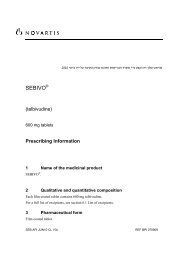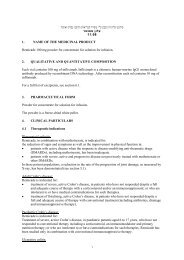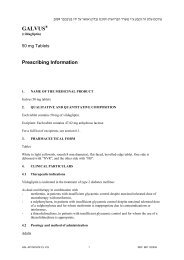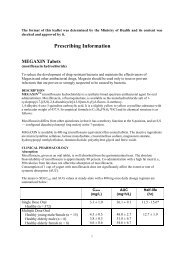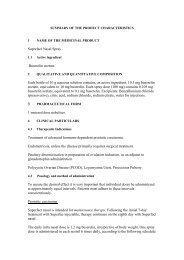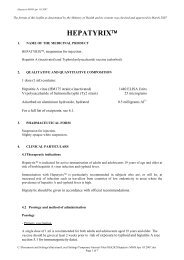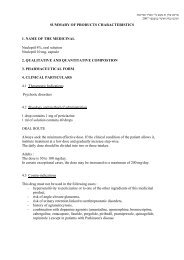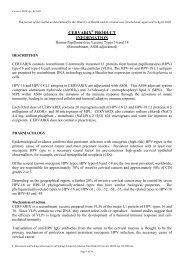FRAXIPARINE For Subcutaneous injection(apart from the kidney ...
FRAXIPARINE For Subcutaneous injection(apart from the kidney ...
FRAXIPARINE For Subcutaneous injection(apart from the kidney ...
Create successful ePaper yourself
Turn your PDF publications into a flip-book with our unique Google optimized e-Paper software.
2336.doc<br />
The format of this leaflet as determined by <strong>the</strong> Ministry of Health and its content was checked and approved in November 2005<br />
<strong>FRAXIPARINE</strong><br />
<strong>For</strong> <strong>Subcutaneous</strong> <strong>injection</strong>(<strong>apart</strong> <strong>from</strong> <strong>the</strong> <strong>kidney</strong> dialysis indication)<br />
PRESCRIBING INFORMATION<br />
1. NAME OF THE MEDICINAL PRODUCT<br />
<strong>FRAXIPARINE</strong> 2850 anti-factor Xa IU/0.3 ml, solution for <strong>injection</strong> in pre-filled syringes<br />
<strong>FRAXIPARINE</strong> 3800 anti-factor Xa IU/0.4 ml, solution for <strong>injection</strong> in pre-filled syringes<br />
<strong>FRAXIPARINE</strong> 5700 anti-factor Xa IU/0.6 ml, solution for <strong>injection</strong> in pre-filled syringes<br />
<strong>FRAXIPARINE</strong> 7600 anti-factor Xa IU/0.8 ml, solution for <strong>injection</strong> in pre-filled syringes<br />
2. QUALITATIVE AND QUANTITATIVE COMPOSITION<br />
Nadroparin Calcium.<br />
2850 I.U AXa/0.3ml<br />
3800 I.U AXa/0.4ml<br />
5700 I.U AXa/0.6ml<br />
7600 I.U AXa/0.8ml<br />
List of Excipients<br />
Calcium Hydroxide solution or dilute<br />
Hydrochloric acid, water for <strong>injection</strong><br />
3. PHARMACEUTICAL FORM<br />
Solution for Injection<br />
4. CLINICAL PARTICULARS<br />
4.1 Therapeutic indications<br />
This heparin is a low molecular weight heparin (LMWH).<br />
Its indications are as follows:<br />
- prevention of venous thrombo-embolic disease in surgery, in moderate to high-risk situations;<br />
- prevention of coagulation of <strong>the</strong> extra-corporal circulation loop during <strong>kidney</strong> dialysis (session<br />
generally lasting ≤ 4 hours);<br />
- curative treatment for established deep-vein thrombosis;<br />
4.2 Posology and method of administration<br />
SUBCUTANEOUS ROUTE (<strong>apart</strong> <strong>from</strong> <strong>the</strong> <strong>kidney</strong> dialysis indication)<br />
This dosage form is suitable for adults.<br />
Do not inject by <strong>the</strong> intramuscular route.<br />
1 ml of <strong>FRAXIPARINE</strong> is equivalent to approximately 9500 anti-factor Xa IU nadroparin.<br />
- <strong>Subcutaneous</strong> <strong>injection</strong> technique<br />
Do not purge <strong>the</strong> air bubble.<br />
\\Appganim\Fda\Mt\Alonim\2336.doc Page 1 of 12
2336.doc<br />
<strong>Subcutaneous</strong> <strong>injection</strong> of nadroparin should preferably be given with <strong>the</strong> patient in <strong>the</strong> decubitus<br />
position, in <strong>the</strong> subcutaneous cellular tissue of <strong>the</strong> anterolateral and posterolateral abdominal girdle,<br />
on <strong>the</strong> right and left side alternately.<br />
The needle must be fully inserted perpendicularly and not tangentially into <strong>the</strong> thickness of a skin<br />
fold made between <strong>the</strong> thumb and <strong>the</strong> index finger of <strong>the</strong> person administering it. This skin fold<br />
must be maintained throughout <strong>the</strong> <strong>injection</strong>.<br />
- General recommendation<br />
Regular monitoring of platelet count is essential throughout treatment due to <strong>the</strong> risk of heparininduced<br />
thrombopenia (HIT) (cf. chapter 4.4 Warnings and precautions for use).<br />
Prevention of venous thrombo-embolic disease in surgery<br />
These recommendations generally apply to surgical procedures performed under general anaes<strong>the</strong>tic.<br />
<strong>For</strong> spinal and epidural anaes<strong>the</strong>sia techniques, <strong>the</strong> value of <strong>injection</strong> before surgery must be assessed<br />
due to <strong>the</strong> increased <strong>the</strong>oretical risk of intraspinal haematoma (cf. Chapter 4.4. Precautions for use).<br />
* Frequency of administration<br />
1 <strong>injection</strong> per day.<br />
* Dose administered<br />
This depends on <strong>the</strong> individual level of risk, related to <strong>the</strong> patient and <strong>the</strong> type of surgery.<br />
- Situation of moderate thrombogenic risk:<br />
In <strong>the</strong> event of surgery with a moderate thrombogenic risk and when <strong>the</strong> patients do not present a<br />
high thrombo-embolic risk, effective prevention of thrombo-embolic disease is obtained by daily<br />
<strong>injection</strong> of a dose of 2850 anti-factor Xa IU (0.3 ml).<br />
The treatment regimen studied includes an initial <strong>injection</strong> conducted 2 hours before surgery.<br />
- Situation of high thrombogenic risk:<br />
. Hip and knee surgery:<br />
The nadroparin dosage depends on <strong>the</strong> weight of <strong>the</strong> patient, at a dosage of 1 daily <strong>injection</strong> of:<br />
• 38 anti-factor Xa IU/kg<br />
before surgery, i.e. 12 hours before <strong>the</strong> procedure,<br />
after surgery, i.e. <strong>from</strong> <strong>the</strong> 12 th hour after <strong>the</strong> end of <strong>the</strong> procedure,<br />
<strong>the</strong>n daily up to <strong>the</strong> 3 rd day after surgery inclusive.<br />
• 57 anti-factor Xa IU/kg <strong>from</strong> <strong>the</strong> 4 th day after surgery.<br />
By way of indication, <strong>the</strong> dosages to be administered as a function of patients’ weights are as<br />
follows:<br />
Bodyweight<br />
(kg)<br />
\\Appganim\Fda\Mt\Alonim\2336.doc Page 2 of 12<br />
<strong>FRAXIPARINE</strong> volume<br />
Per <strong>injection</strong> and per day<br />
Before surgery and<br />
up to <strong>the</strong> 3 rd day<br />
<strong>FRAXIPARINE</strong> volume<br />
Per <strong>injection</strong> and per day<br />
From <strong>the</strong> 4 th day<br />
< 51 0.2 ml 0.3 ml<br />
51 – 70 0.3 ml 0.4 ml<br />
> 70 0.4 ml 0.6 ml<br />
. O<strong>the</strong>r situations:<br />
When <strong>the</strong> thrombo-embolic risk related to <strong>the</strong> type of surgery (in particular, oncological) and/or<br />
<strong>the</strong> patient (in particular, history of thrombo-embolic disease) appears to be increased, a<br />
nadroparin dosage of 2850 IU (0.3 ml) appears to be sufficient.
2336.doc<br />
* Treatment duration:<br />
• Treatment with a LMWH, accompanied by <strong>the</strong> usual elastic lower limb compression<br />
techniques, must be maintained until complete active deambulation of <strong>the</strong> patient.<br />
• In general surgery, <strong>the</strong> duration of LMWH treatment must be less than 10 days, in <strong>the</strong> absence<br />
of any specific venous thrombo-embolic risk related to <strong>the</strong> patient (Cf. Chapter 4.4<br />
Precautions for use, platelet monitoring).<br />
• If <strong>the</strong> venous thrombo-embolic risk persists beyond <strong>the</strong> recommended treatment duration, it is<br />
necessary to consider continuing preventive treatment, notably using oral anticoagulants.<br />
However, <strong>the</strong> clinical benefit of long-term treatment with low molecular weight heparin or<br />
anti-vitamin K has not been evaluated at <strong>the</strong> current time.<br />
. Prevention of coagulation of <strong>the</strong> extra-corporal circulation loop/<strong>kidney</strong> dialysis<br />
INJECTION BY THE INTRAVASCULAR ROUTE (into <strong>the</strong> arterial line of <strong>the</strong> dialysis loop).<br />
In patients given repeated <strong>kidney</strong> dialysis sessions, prevention of coagulation in <strong>the</strong> extra-renal<br />
purification loop is obtained by injecting an initial dose of 65 IU/kg into <strong>the</strong> arterial line of <strong>the</strong><br />
dialysis loop at <strong>the</strong> start of <strong>the</strong> session.<br />
This dose, administered as a single intravascular bolus, is only suitable for dialysis sessions lasting<br />
4 hours or less. It may subsequently be adjusted due to <strong>the</strong> high level of intra- and inter-individual<br />
variability.<br />
By way of indication, <strong>the</strong> dosages to be administered as a function of patients’ weights are as<br />
follows:<br />
Bodyweight <strong>FRAXIPARINE</strong> volume per session<br />
< 51 kg<br />
51 – 70 kg<br />
> 70 kg<br />
\\Appganim\Fda\Mt\Alonim\2336.doc Page 3 of 12<br />
0.3 ml<br />
0.4 ml<br />
0.6 ml<br />
If necessary, <strong>the</strong> dose is adjusted to <strong>the</strong> specific case of each patient and <strong>the</strong> technical dialysis<br />
conditions. In subjects with a haemorrhagic risk, <strong>the</strong> dialysis sessions may be conducted using a<br />
halved dose.<br />
. Curative treatment of deep-vein thrombosis (DVT)<br />
Any suspicion of deep-vein thrombosis must be rapidly confirmed by means of appropriate tests.<br />
* Frequency of administration<br />
2 <strong>injection</strong>s per day, given 12 hours <strong>apart</strong>.<br />
* Dose administered:<br />
The dose per <strong>injection</strong> is 85 anti-factor Xa IU/kg.<br />
The dosage of LMWH has not been evaluated as a function of bodyweight in patients with a<br />
bodyweight of more than 100 kg or less than 40 kg. The efficacy of LMWH may be reduced for<br />
patients weighing more than 100 kg, or <strong>the</strong>re may be an increased haemorrhagic risk for patients<br />
weighing less than 40 kg. Specific clinical monitoring is required.<br />
By way of indication, <strong>the</strong> dosages to be administered as a function of patients’ weights are 0.1<br />
ml/10 kg every 12 hours, as indicated in <strong>the</strong> table below:<br />
Bodyweight <strong>FRAXIPARINE</strong> volume per <strong>injection</strong><br />
40 – 49 kg 0.4 ml
2336.doc<br />
50 – 59 kg<br />
60 – 69 kg<br />
70 – 79 kg<br />
80 – 89 kg<br />
90 – 99 kg<br />
≥ 100 kg<br />
\\Appganim\Fda\Mt\Alonim\2336.doc Page 4 of 12<br />
0.5 ml<br />
0.6 ml<br />
0.7 ml<br />
0.8 ml<br />
0.9 ml<br />
1.0 ml<br />
Adjust <strong>the</strong> volume to be administered by moving <strong>the</strong> piston to <strong>the</strong> desired graduation, holding <strong>the</strong><br />
syringe upright.<br />
* Treatment duration for DVT:<br />
Treatment with LMWH must be quickly switched to oral anticoagulants, unless contraindicated.<br />
The LMWH treatment duration must not exceed 10 days, including <strong>the</strong> stabilising period with<br />
AVKs, unless <strong>the</strong>re are stabilising difficulties (Cf. Chapter 4.4. Precautions for use: platelet<br />
monitoring). Oral anticoagulant treatment should <strong>the</strong>refore be instigated as soon as possible.<br />
.4.3 Contraindications<br />
Irrespective of <strong>the</strong> doses (curative or preventive), this drug MUST NOT BE USED in <strong>the</strong> following<br />
situations:<br />
- hypersensitivity to nadroparin;<br />
- history of severe type-II heparin-induced thrombopenia (or HIT) induced under unfractionated<br />
heparin or under low molecular weight heparin (Cf. Chapter 4.4 Precautions for use);<br />
- haemorrhagic signs or tendencies linked to haemostasis disorders (disseminated intravascular<br />
coagulations may be an exception to this rule if <strong>the</strong>se are not related to heparin treatment – Cf.<br />
Chapter 4.4 Precautions for use);<br />
- organic lesion liable to bleed.<br />
At curative doses, this drug MUST NOT BE USED in <strong>the</strong> following situations:<br />
- intracerebral haemorrhage;<br />
- in <strong>the</strong> absence of data, severe <strong>kidney</strong> failure (defined by creatinine clearance of approximately 30<br />
ml/min according to calculation using <strong>the</strong> Cockroft formula), <strong>apart</strong> <strong>from</strong> <strong>the</strong> specific situation of<br />
dialysis. In severe <strong>kidney</strong> failure, use unfractionated heparin.<br />
<strong>For</strong> calculation of <strong>the</strong> Cockroft formula, it is necessary to have a recent weight of <strong>the</strong> patient (Cf.<br />
Chapter 4.4 Precautions for use).<br />
- In addition, an epidural or spinal anaes<strong>the</strong>tic must never be given in <strong>the</strong> event of curative<br />
treatment with LMWH.<br />
At curative doses, this drug is NOT GENERALLY RECOMMENDED in <strong>the</strong> following situations:<br />
- extensive ischemic cerebrovascular accident in <strong>the</strong> acute phase, with or without impaired<br />
consciousness. When <strong>the</strong> stroke is of embolic origin, <strong>the</strong> period to be complied with is 72 hours.<br />
Evidence of <strong>the</strong> efficacy of LMWH at curative doses has not, however, been established to date,<br />
irrespective of <strong>the</strong> cause, extent and clinical severity of <strong>the</strong> cerebral infarction;<br />
- acute infectious endocarditis (<strong>apart</strong> <strong>from</strong> certain emboligenic cardiopathies);<br />
- mild to moderate <strong>kidney</strong> failure (creatinine clearance > 30 and < 60 ml/min).<br />
In addition, this drug at curative doses is NOT GENERALLY RECOMMENDED in subjects of any<br />
age in combination with (Cf. Chapter 4.5 Interactions with o<strong>the</strong>r medicinal products and o<strong>the</strong>r forms<br />
of interactions)<br />
+ acetylsalicylic acid at analgesic, antipyretic and anti-inflammatory doses,<br />
+ NSAIDs (systemic route),<br />
+ dextran 40 (parenteral route).<br />
At preventive doses, this drug is NOT GENERALLY RECOMMENDED in <strong>the</strong> following situations:
2336.doc<br />
- severe <strong>kidney</strong> failure (creatinine clearance of approximately 30 ml/min according to calculation<br />
using <strong>the</strong> Cockroft formula, Cf. Chapter 4.4 Precautions for use),<br />
- within <strong>the</strong> first 24 hours following an intracerebral haemorrhage.<br />
In addition, at preventive doses, this drug is NOT GENERALLY RECOMMENDED in elderly<br />
subjects over <strong>the</strong> age of 65, in combination with (Cf. Chapter 4.5 Interactions with o<strong>the</strong>r medicinal<br />
products and o<strong>the</strong>r forms of interactions):<br />
+ acetylsalicylic acid at analgesic, antipyretic and anti-inflammatory doses,<br />
+ NSAIDs (systemic route),<br />
+ dextran 40 (parenteral route).<br />
4.4 Special warnings and special precautions for use<br />
Although <strong>the</strong> various proprietary low molecular weight heparin products all have <strong>the</strong>ir concentrations<br />
expressed in anti-factor Xa international units, <strong>the</strong>ir efficacy is not limited to this anti-factor Xa<br />
activity. It would be dangerous to substitute <strong>the</strong> dosage regimen of one LMWH for ano<strong>the</strong>r, since<br />
each regimen has been validated by specific clinical trials. Particular caution is <strong>the</strong>refore required and<br />
<strong>the</strong> specific instructions for use for each proprietary medicinal product must be complied with.<br />
Warnings<br />
. Haemorrhagic risk<br />
It is essential to follow <strong>the</strong> recommended treatment regimens (dosages and treatment durations).<br />
O<strong>the</strong>rwise, haemorrhagic accidents could occur, particularly in patients at risk (elderly subjects,<br />
patients with <strong>kidney</strong> failure, etc.).<br />
Serious haemorrhagic accidents have notably been observed:<br />
- in <strong>the</strong> elderly, in particular due to <strong>the</strong> deterioration in <strong>kidney</strong> function related to age,<br />
- in <strong>the</strong> event of <strong>kidney</strong> failure,<br />
- in <strong>the</strong> event of a bodyweight under 40 kg<br />
- in <strong>the</strong> event of treatment prolonged beyond <strong>the</strong> recommended mean duration of 10 days,<br />
- in <strong>the</strong> event of non-compliance with <strong>the</strong> recommended treatment conditions (in particular<br />
treatment duration and dosage adjustment on <strong>the</strong> basis of weight for curative treatments),<br />
- in <strong>the</strong> event of combination with drugs increasing <strong>the</strong> haemorrhagic risk<br />
(Cf. Chapter 4.5 Interactions with o<strong>the</strong>r medicinal products and o<strong>the</strong>r forms of interactions).<br />
In all cases, specific monitoring is essential in <strong>the</strong> elderly and/or subjects with <strong>kidney</strong> failure, and<br />
also in <strong>the</strong> event of long-term treatment for more than 10 days. In order to detect any<br />
accumulation, measurement of anti-factor Xa activity can be useful in certain cases (Cf. Chapter<br />
4.4 Precautions for use/Laboratory monitoring).<br />
. Risk of heparin-induced thrombopenia (HIT)<br />
In <strong>the</strong> event of a patient treated with LMWH (at curative or preventive doses) presenting a<br />
thrombotic event, such as:<br />
- an exacerbation of <strong>the</strong> thrombosis for which he/she is being treated,<br />
- phlebitis,<br />
- pulmonary embolism,<br />
- acute ischemia of <strong>the</strong> lower limbs,<br />
- or even myocardial infarction or ischemic cerebrovascular accident,<br />
one must systematically consider heparin-induced thrombopenia (HIT) and urgently perform a<br />
platelet count (Cf. Chapter 4.4 Precautions for use).<br />
. Use in children<br />
In <strong>the</strong> absence of data, <strong>the</strong> use of LMWHs in children is not recommended.<br />
\\Appganim\Fda\Mt\Alonim\2336.doc Page 5 of 12
2336.doc<br />
Precautions for use<br />
. Kidney function<br />
Before starting treatment with LMWH, it is essential to assess <strong>kidney</strong> function, particularly in <strong>the</strong><br />
elderly over <strong>the</strong> age of 75 years, calculating creatinine clearance (Clcr) using <strong>the</strong> Cockroft formula<br />
and on <strong>the</strong> basis of a recent weight for <strong>the</strong> patient:<br />
In men, Clcr = (140 – age) x weight / (0.814 x serum creatinine) with age expressed in years,<br />
weight in kg and serum creatinine in µmol/l.<br />
This formula must be corrected for women by multiplying <strong>the</strong> result by 0.85.<br />
When creatinine is expressed in mg/ml, multiply by a factor of 8.8.<br />
Detection of severe <strong>kidney</strong> failure (Clcr of approximately 30 ml/min) contraindicates <strong>the</strong><br />
prescription of LMWH in curative indications (Cf. Chapter 4.3 Contraindications).<br />
. Laboratory monitoring<br />
* Platelet monitoring<br />
Heparin-induced thrombopenia (or HIT)<br />
There is a risk of severe thrombopenia, sometimes causing thrombosis, induced by heparin<br />
(unfractionated heparin and, less commonly, low molecular weight heparins), of immunological<br />
origin, called type II thrombopenia (see also Chapter 4.8 Undesirable effects).<br />
Due to <strong>the</strong> risk of HIT, monitoring of platelet count is necessary, irrespective of <strong>the</strong> indication for<br />
treatment and <strong>the</strong> dosage administered. Perform a platelet count before treatment or, at <strong>the</strong> latest,<br />
within 24 hours after treatment instigation, <strong>the</strong>n twice weekly throughout <strong>the</strong> usual duration of <strong>the</strong><br />
treatment.<br />
HIT must be suspected if <strong>the</strong> platelet count is < 100,000/mm 3 and/or <strong>the</strong>re is a relative fall in<br />
platelets of 30 to 50% in 2 successive counts. It mainly develops between <strong>the</strong> 5 th and 21 st day<br />
following <strong>the</strong> start of heparin treatment (with a peak in frequency at around <strong>the</strong> 10 th day).<br />
But it can occur much earlier when <strong>the</strong>re is a history of thrombopenia under heparin treatment and<br />
isolated cases have been reported beyond 21 days. This type of history must be systematically<br />
investigated during an in-depth interview prior to treatment. In addition, <strong>the</strong> risk of recurrence in<br />
<strong>the</strong> event of <strong>the</strong> reintroduction of heparin could persist for several years or even indefinitely (Cf.<br />
Chapter 4.3 Contraindications).<br />
In all cases, <strong>the</strong> onset of HIT is an emergency situation and requires specialist advice.<br />
Any significant fall (30 to 50% of <strong>the</strong> initial value) in platelet count must be seen as an alert,<br />
before <strong>the</strong> value reaches a critical level. Observation of a fall in <strong>the</strong> number of platelets always<br />
demands:<br />
1) - an immediate platelet count;<br />
2) – <strong>the</strong> suspension of heparin treatment if <strong>the</strong> fall is confirmed or even accentuated at this count,<br />
in <strong>the</strong> absence of any o<strong>the</strong>r obvious cause.<br />
A sample must be taken in a citrate tube to perform platelet aggregation tests in vitro and<br />
immunological tests. But, under <strong>the</strong>se conditions, <strong>the</strong> immediate measures to be taken do not<br />
depend on <strong>the</strong> results of <strong>the</strong>se in vitro or immunological platelet aggregation tests because only a<br />
few specialised laboratories conduct <strong>the</strong>m routinely and <strong>the</strong> results are obtained, at best, only after<br />
several hours. These tests must none<strong>the</strong>less be performed to assist <strong>the</strong> diagnosis of this<br />
complication since if heparin treatment is continued, <strong>the</strong>re is a major risk of thrombosis.<br />
3) – prevention or treatment of thrombotic complications of HIT.<br />
If it appears to be essential to continue anticoagulation, heparin must be replaced with ano<strong>the</strong>r<br />
class of antithrombotic: danaparoid sodium or hirudin, prescribed at preventive or curative doses<br />
depending on <strong>the</strong> case. Substitution with AVKs should only take place once <strong>the</strong> platelet count has<br />
normalised, due to <strong>the</strong> risk of exacerbation of <strong>the</strong> thrombotic phenomenon by AVKs.<br />
\\Appganim\Fda\Mt\Alonim\2336.doc Page 6 of 12
2336.doc<br />
* Substitution of heparin with AVKs<br />
In this case, reinforce clinical and laboratory monitoring (Quick time expressed in INR) to<br />
monitor <strong>the</strong> effect of AVKs.<br />
Due to <strong>the</strong> latency time prior to <strong>the</strong> full effect of <strong>the</strong> antivitamin K used, heparin must be<br />
maintained at an equivalent dose for as long as necessary to ensure that <strong>the</strong> INR is within <strong>the</strong><br />
desired <strong>the</strong>rapeutic zone of <strong>the</strong> indication at two successive controls.<br />
* Control of anti-factor Xa activity<br />
Since <strong>the</strong> majority of clinical trials demonstrating <strong>the</strong> efficacy of LMWH have been conducted at<br />
a dose tailored to bodyweight and without any specific laboratory monitoring, <strong>the</strong> value of this<br />
type of laboratory monitoring has not been established to assess <strong>the</strong> efficacy of LMWH. However,<br />
laboratory monitoring by determination of anti-factor Xa activity may be useful to manage <strong>the</strong><br />
haemorrhagic risk in some clinical situations frequently associated with a risk of overdose.<br />
These situations mainly concern <strong>the</strong> curative indications of LMWH, due to <strong>the</strong> doses<br />
administered, when <strong>the</strong>re is:<br />
- mild to moderate <strong>kidney</strong> failure (clearance calculated using <strong>the</strong> Cockroft formula of around 30<br />
to 60 ml/min): in fact, in contrast with unfractionated standard heparin, LMWHs are largely<br />
eliminated by <strong>the</strong> <strong>kidney</strong>s and any impaired <strong>kidney</strong> function can lead to relative overdose. As<br />
for severe <strong>kidney</strong> failure, this is a contraindication to <strong>the</strong> use of LMWHs at curative doses (Cf.<br />
Chapter 4.3 Contraindications);<br />
- an extreme weight (underweight or even cachexia, obesity);<br />
- unexplained haemorrhage.<br />
Conversely, laboratory monitoring is not recommended at preventive doses if treatment with<br />
LMWH complies with <strong>the</strong> recommended treatment conditions (particularly for treatment duration)<br />
and during <strong>kidney</strong> dialysis.<br />
In order to detect a possible accumulation after several administrations, it is recommended that a<br />
blood sample be taken <strong>from</strong> <strong>the</strong> patient if necessary at <strong>the</strong> peak activity (according to <strong>the</strong> data<br />
available), i.e.:<br />
- approximately 4 hours after <strong>the</strong> 3 rd administration, when <strong>the</strong> drug is given as<br />
2 SC <strong>injection</strong>s per day,<br />
- approximately 4 hours after <strong>the</strong> 2 nd administration, when <strong>the</strong> drug is given as<br />
1 SC <strong>injection</strong> per day.<br />
Repetition of assay of anti-factor Xa activity to measure serum heparin levels – every 2 to 3 days,<br />
for example – should be discussed on a case-by-case basis, depending on <strong>the</strong> results of <strong>the</strong><br />
previous assay and adjustment of <strong>the</strong> LMWH dose should be considered if necessary.<br />
<strong>For</strong> each LMWH and each treatment regimen, <strong>the</strong> anti-factor Xa activity generated is different.<br />
By way of indication and according to <strong>the</strong> data available, <strong>the</strong> mean observed (± standard<br />
deviation) at <strong>the</strong> 4 th hour for nadroparin, administered:<br />
- at a dose of 83 IU/kg by <strong>injection</strong>, as 2 <strong>injection</strong>s per 24 hours, was 1.01 ± 0.18 IU.<br />
- at a dose of 166 IU/kg as 1 <strong>injection</strong> per 24 hours, was 1.34 ± 0.15 IU.<br />
This mean value was observed during clinical trials for assays of anti-factor Xa activity conducted<br />
using <strong>the</strong> chromogenic method (amidolytic).<br />
* Activated partial thromboplastin time (APTT)<br />
Certain LMWHs moderately prolong APTT. In <strong>the</strong> absence of any established clinical relevance,<br />
any treatment monitoring based on this test is pointless.<br />
. Administration of spinal/epidural anaes<strong>the</strong>tic in <strong>the</strong> event of preventive treatment with LMWH<br />
\\Appganim\Fda\Mt\Alonim\2336.doc Page 7 of 12
2336.doc<br />
- As with o<strong>the</strong>r anticoagulants, rare cases of intraspinal haematoma leading to long-term or<br />
permanent paralysis have been reported during <strong>the</strong> administration of LMWH during spinal or<br />
epidural anaes<strong>the</strong>tic.<br />
The risk of intraspinal haematoma appears to be higher with an epidural using a ca<strong>the</strong>ter than<br />
with a spinal anaes<strong>the</strong>tic.<br />
The risk of <strong>the</strong>se rare events may be increased by <strong>the</strong> prolonged use of epidural ca<strong>the</strong>ters after<br />
surgery.<br />
- If pre-surgical treatment with LMWH is necessary (prolonged bed rest, injury) and <strong>the</strong> benefit<br />
of a loco-regional spinal anaes<strong>the</strong>tic has been carefully evaluated, this technique may be used<br />
in a patient having received an <strong>injection</strong> of LMWH before surgery, as long as a period of at<br />
least 12 hours is left between <strong>the</strong> heparin <strong>injection</strong> and administration of <strong>the</strong> spinal anaes<strong>the</strong>tic.<br />
Careful neurological monitoring is recommended due to <strong>the</strong> risk of intraspinal haematoma.<br />
In almost all cases, preventive treatment with LMWH can be started within 6 to 8 hours<br />
following <strong>the</strong> technique or removal of <strong>the</strong> ca<strong>the</strong>ter, under neurological monitoring.<br />
Particular caution is required in <strong>the</strong> event of combination with o<strong>the</strong>r drugs interfering with<br />
haemostasis (notably nonsteroidal anti-inflammatories, aspirin).<br />
. Situations at risk<br />
Monitoring of treatment should be reinforced in <strong>the</strong> following cases:<br />
. liver failure,<br />
. history of gastrointestinal ulcers or any o<strong>the</strong>r organic lesions liable to bleed,<br />
. vascular diseases of <strong>the</strong> chorioretina,<br />
. in <strong>the</strong> post-operative period following brain and spinal bone marrow surgery, <strong>the</strong><br />
performance of a lumbar puncture must be discussed, taking into account <strong>the</strong> risk of<br />
intraspinal bleeding. It must be deferred wherever possible.<br />
4.5 Interactions with o<strong>the</strong>r medicinal products and o<strong>the</strong>r forms of interaction<br />
Certain drugs or <strong>the</strong>rapeutic classes are liable to promote <strong>the</strong> onset of hyperkalaemia: potassium salts,<br />
hyperkalaemic diuretics, conversion enzyme inhibitors, angiotensin II inhibitors, nonsteroidal antiinflammatories,<br />
heparins (low molecular weight or unfractionated), ciclosporin and tacrolimus,<br />
trimethoprim.<br />
The onset of hyperkalaemia may depend on <strong>the</strong> existence of concomitant risk factors.<br />
This risk is increased in <strong>the</strong> event of combination with <strong>the</strong> above mentioned drugs.<br />
1. In subjects under <strong>the</strong> age of 65 at curative LMWH doses,<br />
and in <strong>the</strong> elderly (> 65 years) irrespective of <strong>the</strong> LMWH dose<br />
Inadvisable combinations<br />
+ Acetylsalicylic acid at analgesic, antipyretic and anti-inflammatory doses (and, by<br />
extrapolation, o<strong>the</strong>r salicylates)<br />
Increase in haemorrhagic risk (inhibition of platelet function and aggression of <strong>the</strong> gastroduodenal<br />
mucosa by salicylates),<br />
Use a non-salicylate antipyretic analgesic (such as paracetamol).<br />
+ NSAIDs (systemic route)<br />
Increase in haemorrhagic risk (inhibition of platelet function and aggression of <strong>the</strong> gastroduodenal<br />
mucosa by nonsteroidal anti-inflammatories),<br />
If <strong>the</strong> combination cannot be avoided, close clinical monitoring.<br />
+ Dextran 40 (parenteral route)<br />
Increase in haemorrhagic risk (inhibition of platelet function by Dextran 40).<br />
\\Appganim\Fda\Mt\Alonim\2336.doc Page 8 of 12
2336.doc<br />
Combinations requiring precautions for use<br />
+ Oral anticoagulants<br />
Potentiation of anticoagulant action<br />
When switching <strong>from</strong> heparin to an oral anticoagulant, reinforce clinical monitoring.<br />
Combinations to be taken into account<br />
+ Platelet anti-aggregants (o<strong>the</strong>r than acetylsalicylic acid at analgesic, antipyretic and antiinflammatory<br />
doses; NSAIDs): abciximab, acetylsalicylic acid at anti-aggregant doses in<br />
cardiological and neurological indications, beraprost, clopidogrel, eptifibatide, iloprost,<br />
ticlopidine, tirofiban<br />
Increase in haemorrhagic risk.<br />
2. In subjects under <strong>the</strong> age of 65 at preventive LMWH doses<br />
Combinations to be taken into account<br />
The concomitant use of drugs acting at various levels on haemostasis increases <strong>the</strong> risk of bleeding.<br />
Thus, irrespective of age, combination of LMWHs at preventive doses with oral anticoagulants,<br />
platelet anti-aggregants (abciximab, NSAIDs, acetylsalicylic acid irrespective of dose, clopidogrel,<br />
eptifibatide, iloprost, ticlopidine, tirofiban) and thrombolytics must be taken into account, maintaining<br />
clinical and, if necessary, laboratory monitoring.<br />
4.6 Pregnancy and lactation<br />
Pregnancy<br />
Studies conducted in animals have not revealed any teratogenic effect of nadroparin.<br />
In <strong>the</strong> absence of any teratogenic effect in animals, no malformative effect is expected in humans. In<br />
fact, to date, substances responsible for malformations in humans have been shown to be teratogenic<br />
in animals during properly conducted studies in two species.<br />
Preventive treatment in <strong>the</strong> 1 st trimester and curative treatment<br />
In a clinical context, <strong>the</strong>re are not yet enough relevant data in order to evaluate a possible teratogenic<br />
or foetotoxic effect of nadroparin when administered at a preventive dose during <strong>the</strong> first trimester of<br />
pregnancy or at a curative dose throughout pregnancy.<br />
Consequently, as a precautionary measure, it is preferable to avoid use of nadroparin at a preventive<br />
dose during <strong>the</strong> first trimester of pregnancy or at a curative dose throughout pregnancy.<br />
Preventive treatment in <strong>the</strong> 2 nd and 3 rd trimesters<br />
In a clinical context, <strong>the</strong> use of nadroparin during <strong>the</strong> 2 nd and 3 rd trimesters of a limited number of<br />
pregnancies does not appear to have evidenced any teratogenic or foetotoxic effects to date. However,<br />
fur<strong>the</strong>r studies are necessary in order to evaluate <strong>the</strong> consequences of exposure under <strong>the</strong>se conditions.<br />
Consequently, <strong>the</strong> use of nadroparin at a preventive dose during <strong>the</strong> 2 nd and 3 rd trimesters of<br />
pregnancy must only be envisaged during pregnancy if necessary.<br />
If epidural anaes<strong>the</strong>sia is envisaged, it is advisable to suspend heparin treatment at <strong>the</strong> latest within 12<br />
hours prior to anaes<strong>the</strong>sia, insofar as possible, for preventive treatment.<br />
Breast-feeding<br />
Since gastrointestinal absorption in neonates is, in principle, unlikely, treatment with nadroparin is not<br />
contraindicated in breast-feeding women.<br />
\\Appganim\Fda\Mt\Alonim\2336.doc Page 9 of 12
2336.doc<br />
4.7 Effects on ability to drive and use machines<br />
Not applicable.<br />
4.8 Undesirable effects<br />
- Haemorrhagic signs: <strong>the</strong>se mainly occur in <strong>the</strong> presence of:<br />
• Concomitant risk factors: organic lesions liable to bleed, certain drug combinations<br />
(Cf. Chapter 4.3 Contraindications and 4.5 Interactions with o<strong>the</strong>r medicinal products and o<strong>the</strong>r<br />
forms of interactions), age, <strong>kidney</strong> failure, low bodyweight<br />
• Non-compliance with treatment conditions, notably treatment duration and adjustment of dose on<br />
<strong>the</strong> basis of weight (Cf. Chapter 4.4 Warnings/haemorrhagic risk).<br />
Rare cases of intraspinal haematomas have been reported in <strong>the</strong> event of administration of low<br />
molecular weight heparins during spinal anaes<strong>the</strong>tic, or epidural analgesia or anaes<strong>the</strong>tic.<br />
These events have led to neurological damage of variable severity, including long-term or<br />
permanent paralysis (Cf. Chapter 4.4 Precautions for use).<br />
- Administration by <strong>the</strong> subcutaneous route can cause <strong>the</strong> onset of haematomas at <strong>the</strong> <strong>injection</strong> site.<br />
These are exacerbated by non-compliance with <strong>the</strong> <strong>injection</strong> method or <strong>the</strong> use of unsuitable<br />
<strong>injection</strong> equipment. Firm nodules disappearing within a few days reflect an inflammatory<br />
process, which does not warrant withdrawal of treatment.<br />
- Cases of thrombopenia have been reported. There are two types:<br />
. <strong>the</strong> most common one – type I – is usually moderate (> 100,000/mm 3 ), of early onset (before <strong>the</strong><br />
5 th day) and does not require withdrawal of treatment,<br />
. in rare cases, severe type-II immuno-allergic thrombopenia (HIT). The prevalence of this is still<br />
poorly evaluated (Cf. Chapter 4.4 Warnings and Precautions for use).<br />
- Rare cases of cutaneous necrosis at <strong>the</strong> <strong>injection</strong> site have been reported with heparins. These<br />
reactions may be preceded by purpura or ery<strong>the</strong>matous, infiltrated and painful patches. Treatment<br />
must be suspended immediately.<br />
- Rare cutaneous or systemic allergic signs, which may, in certain cases, lead to treatment<br />
withdrawal.<br />
- The risk of osteoporosis cannot be excluded in long-term treatment, as is <strong>the</strong> case with<br />
unfractionated heparins.<br />
- Transient elevation in transaminase levels.<br />
- A few cases of hyperkalaemia.<br />
4.9 Overdose<br />
- Accidental overdose following <strong>the</strong> subcutaneous administration of massive doses of low molecular<br />
weight heparin could cause haemorrhagic complications.<br />
In <strong>the</strong> event of haemorrhage, treatment with protamine sulphate may be indicated in certain cases,<br />
taking into account <strong>the</strong> following facts:<br />
. its efficacy is significantly less than that reported in <strong>the</strong> event of overdose with unfractionated<br />
heparin;<br />
. due to its adverse events (in particular, anaphylactic shock), <strong>the</strong> benefit/risk ratio of protamine<br />
sulphate must be carefully assessed before it is prescribed.<br />
In this event, neutralisation is conducted by slow intravenous <strong>injection</strong> of protamine (sulphate or<br />
hydrochloride).<br />
The effective protamine dose depends on:<br />
. <strong>the</strong> heparin dose injected (100 anti-heparin units of protamine can be used to neutralise <strong>the</strong> activity<br />
of 100 anti-factor Xa IU of low molecular weight heparin),<br />
. <strong>the</strong> time elapsed since <strong>injection</strong> of <strong>the</strong> heparin, with possible reduction of <strong>the</strong> antidote doses.<br />
Never<strong>the</strong>less, it is not possible to totally neutralise <strong>the</strong> anti-factor Xa activity.<br />
\\Appganim\Fda\Mt\Alonim\2336.doc Page 10 of 12
2336.doc<br />
Moreover, <strong>the</strong> absorption kinetics of low molecular weight heparin may make this neutralisation<br />
transient and require fragmentation of <strong>the</strong> total calculated protamine dose into several <strong>injection</strong>s (2<br />
to 4) divided over 24 hours.<br />
- In <strong>the</strong> event of ingestion – even massive – of low molecular weight heparin (no cases reported), no<br />
serious consequences are, in principle, expected, given <strong>the</strong> very low gastrointestinal absorption of<br />
<strong>the</strong> product.<br />
5. PHARMACOLOGICAL PROPERTIES<br />
5.1 Pharmacodynamic properties<br />
B01 AB 06: ANTI-THROMBOTICS<br />
- Nadroparin is a low molecular weight heparin in which <strong>the</strong> antithrombotic and anticoagulant<br />
properties of standard heparin have been split.<br />
It is characterised by a higher anti-factor Xa activity than anti-factor IIa or thrombotic activity. <strong>For</strong><br />
nadroparin, <strong>the</strong> ratio between <strong>the</strong>se two activities is between 2.5 and 4.<br />
- At prophylactic doses, nadroparin does not cause any marked changes in APTT.<br />
At curative doses, at <strong>the</strong> peak activity, APTT may be prolonged to 1.4 times <strong>the</strong> reference time.<br />
This prolongation is a reflection of <strong>the</strong> residual antithrombotic effect of nadroparin.<br />
5.2 Pharmacokinetic properties<br />
The pharmacokinetic parameters are studied on <strong>the</strong> basis of <strong>the</strong> evolution in plasma anti-factor Xa<br />
activities.<br />
- Bioavailability<br />
After subcutaneous <strong>injection</strong>, almost 100% of <strong>the</strong> product is rapidly absorbed. Peak plasma<br />
activity is reached between <strong>the</strong> 3 rd and <strong>the</strong> 4 th hour if nadroparin is administered as 2 <strong>injection</strong>s per<br />
day.<br />
This peak is shifted to between <strong>the</strong> 4 th and <strong>the</strong> 6 th hour if nadroparin is administered<br />
as 1 <strong>injection</strong> per day.<br />
- Metabolism<br />
This mainly occurs in <strong>the</strong> liver (desulfatation, depolymerisation).<br />
- Distribution<br />
After subcutaneous <strong>injection</strong>, <strong>the</strong> half-life of anti-factor Xa activity is higher for low molecular<br />
weight heparins than for unfractionated heparins.<br />
This half-life is around 3 to 4 hours.<br />
As for <strong>the</strong> anti-factor IIa activity, this disappears more rapidly <strong>from</strong> <strong>the</strong> plasma than <strong>the</strong> anti-factor<br />
Xa activity with low molecular weight heparins.<br />
- Elimination<br />
Elimination is primarily by <strong>the</strong> renal route in little or non-metabolised form.<br />
- Populations at risk<br />
* The elderly:<br />
In <strong>the</strong> elderly, since <strong>kidney</strong> function is physiologically reduced, elimination is slowed down. This<br />
modification does not affect <strong>the</strong> doses and rhythm of <strong>injection</strong>s for preventive treatment as long as<br />
<strong>the</strong> <strong>kidney</strong> function of <strong>the</strong>se patients remains within acceptable limits, i.e. only slightly impaired.<br />
\\Appganim\Fda\Mt\Alonim\2336.doc Page 11 of 12
2336.doc<br />
It is essential to systematically assess <strong>the</strong> <strong>kidney</strong> function of elderly subjects over <strong>the</strong> age of 75<br />
using <strong>the</strong> Cockroft formula, before instigating LMWH treatment (Cf. Chapter 4.4 Precautions for<br />
use).<br />
* Mild to moderate <strong>kidney</strong> failure (creatinine clearance > 30 ml/min):<br />
It may be useful in certain cases to monitor circulating anti-factor Xa activity to eliminate <strong>the</strong><br />
possibility of overdose in curative indications (Cf. Chapter 4.4. Precautions for use).<br />
* Kidney dialysis:<br />
Low molecular weight heparin is injected into <strong>the</strong> arterial line of <strong>the</strong> dialysis loop at high enough<br />
doses to prevent coagulation of <strong>the</strong> loop.<br />
In principle, <strong>the</strong> pharmacokinetic parameters are not modified, except for in <strong>the</strong> event of overdose,<br />
when passage into <strong>the</strong> systemic circulation can lead to an increased anti-factor Xa activity, related<br />
to <strong>the</strong> terminal <strong>kidney</strong> failure.<br />
5.3 Preclinical safety data<br />
Not applicable.<br />
6. PHARMACEUTICAL PARTICULARS<br />
6.1 Incompatibilities<br />
Not applicable.<br />
6.2 Shelf life<br />
3 years.<br />
6.3 Special precautions for storage<br />
Store at below 30°C.<br />
Store in original packaging until time of use.<br />
6.4 Nature and contents of container<br />
0.3 ml or 0.4 ml or 0.6 ml or 0.8 ml of injectable solution in a pre-filled syringe (glass) with security<br />
device; transparent plastic sleeve; box of 2 or 10<br />
MANUFACTURED BY:<br />
Glaxowellcome Production, France<br />
LICENSE HOLDER:<br />
GlaxoSmithKline (Israel) Ltd.<br />
25 Basel St., Petach Tikva 49002<br />
LICENSE NUMBER:<br />
<strong>FRAXIPARINE</strong> 2850 IU AXa/ 0.3 ML 133-26-29794<br />
<strong>FRAXIPARINE</strong> 3800 IU AXa/ 0.4 ML 121-17-30055<br />
<strong>FRAXIPARINE</strong> 5700 IU AXa/ 0.6 ML 133-27-29795<br />
<strong>FRAXIPARINE</strong> 7600 IU AXa/ 0.8 ML 133-28-29496<br />
\\Appganim\Fda\Mt\Alonim\2336.doc Page 12 of 12



